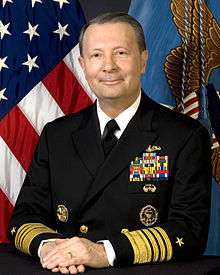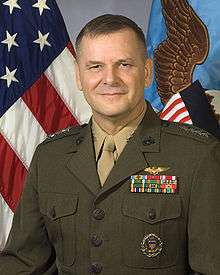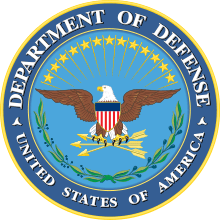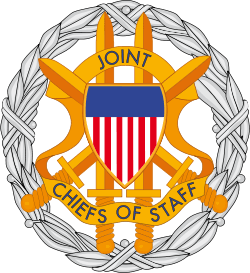Vice Chairman of the Joint Chiefs of Staff
| Vice Chairman of the Joint Chiefs of Staff | |
|---|---|
|
Flag of the Vice Chairman of the JCS | |
| U.S. Department of Defense | |
| Member of |
Defense Acquisition Board Joint Chiefs of Staff Joint Requirements Oversight Council |
| Reports to |
The President Secretary of Defense Chairman of the Joint Chiefs of Staff |
| Seat | The Pentagon, Arlington County, Virginia, U.S. |
| Appointer |
The President with Senate advice and consent |
| Term length |
2 years Renewable |
| Constituting instrument | 10 U.S.C. § 154 |
| Precursor | None |
| Formation | February 6, 1987 |
| First holder | Robert T. Herres |
| Deputy | Director of the Joint Staff |
| Website | Official Website |
The Vice Chairman of the Joint Chiefs of Staff (VJCS) is, by U.S. law, the second highest-ranking military officer in the United States Armed Forces [1] ranking just below the Chairman of the Joint Chiefs of Staff. The Vice Chairman outranks all respective heads of each service branch, with the exception of the Chairman, but does not have operational command authority over their service branches.[1] The Goldwater–Nichols Act of 1986 created the position of VJCS to assist the Chairman in exercising his duties. In the absence of the Chairman, the Vice Chairman presides over the meetings of the Joint Chiefs of Staff and all other duties prescribed under 10 U.S.C. § 153 and may also perform other duties that the President, the Chairman, or the Secretary of Defense prescribes.[1]
Responsibilities
Although the office of Vice Chairman of the Joint Chiefs of Staff is considered to be very important and highly prestigious, neither the Vice Chairman nor the Joint Chiefs of Staff as a body have any command authority over combatant forces. The chain of command runs from the President to the Secretary of Defense directly to the commanders of the Unified Combatant Commands.[2] The Vice Chairman is nominated by the President for appointment and must be confirmed via majority vote by the Senate.[1] The Chairman and Vice Chairman may not be members of the same armed force service branch.[1] However, the President may waive that restriction for a limited period of time in order to provide for the orderly transition of officers appointed to serve in those positions.[1] The Vice Chairman serves a two-year term of office at the pleasure of the President,[1] but can be reappointed to serve two additional terms for a total of six years.[1] In case of times of war or national emergency, there is no limit to how many times an officer can be reappointed to serve as Vice Chairman.[1] Historically, the Vice Chairman has served two terms. By statute, the Vice Chairman is appointed as a four-star general or admiral.[1]
List of Vice Chairmen
| Name | Photo | Branch | Term began | Term ended | |
|---|---|---|---|---|---|
| 1. | Gen Robert T. Herres | | USAF | February 6, 1987 | February 28, 1990 |
| 2. | ADM David E. Jeremiah | | USN | March 1, 1990 | February 28, 1994 |
| 3. | ADM William "Bill" Owens | | USN | March 1, 1994 | February 27, 1996 |
| 4. | Gen Joseph Ralston |  | USAF | March 1, 1996 | February 29, 2000 |
| 5. | Gen Richard Myers |  | USAF | February 29, 2000 | October 1, 2001 |
| 6. | Gen Peter Pace |  | USMC | October 1, 2001 | August 12, 2005 |
| 7. | ADM Edmund Giambastiani |  | USN | August 12, 2005 | July 27, 2007 |
| 8. | Gen James E. Cartwright |  | USMC | August 31, 2007 | August 3, 2011 |
| 9. | ADM James A. Winnefeld, Jr. |  | USN | August 4, 2011 | July 31, 2015 |
| 10. | Gen Paul J. Selva | .jpg) | USAF | July 31, 2015 | Incumbent |
 - Later served as Chairman of the Joint Chiefs
- Later served as Chairman of the Joint Chiefs - Served as acting Chairman
- Served as acting Chairman
Vice Chairman by Branch of Service
- Air Force - 4
- Army - none
- Marine Corps - 2
- Navy - 4
Positional Color

The positional color (flag) of the Vice Chairman of the Joint Chiefs of Staff is white with a diagonal medium blue strip from upper hoist to lower fly. Centered on the flag is an American bald eagle with wings spread horizontally, in proper colors. The talons grasp three crossed arrows. A shield with blue chief and thirteen red and white stripes is on the eagle’s breast. Diagonally, from upper fly to lower hoist are four five-pointed stars, medium blue on the white, two above the eagle, and two below. The fringe is yellow; the cord and tassels are medium blue and white. The design was approved by Secretary of Defense Caspar Weinberger on 20 January 1987.[3]
See also
- Chairman of the Joint Chiefs of Staff
- Defense Acquisition Board
- Deputy's Advisory Working Group, a policy review panel co-chaired by DEPSECDEF and VCJCS.
- Joint Requirements Oversight Council


